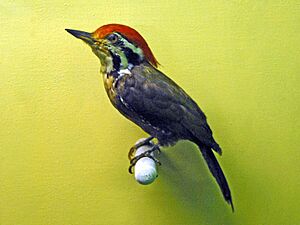Olive-backed woodpecker facts for kids
Quick facts for kids Olive-backed woodpecker |
|
|---|---|
 |
|
| from Malaysia. Stuffed specimen | |
| Conservation status | |
| Scientific classification | |
| Genus: |
Gecinulus
|
| Species: |
rafflesii
|
The olive-backed woodpecker (Gecinulus rafflesii) is a cool bird that belongs to the woodpecker family, Picidae. You can find this bird living in the forests of Southeast Asia.
Contents
About the Olive-backed Woodpecker
The olive-backed woodpecker was first described by an Irish zoologist named Nicholas Aylward Vigors in 1830. He studied a bird specimen that was collected by Stamford Raffles. Vigors decided to name the bird Picus rafflesii to honor Raffles. The first bird studied came from Sumatra. Today, this woodpecker is placed in a different group of birds called the Dinopium genus. This group was named by a French expert, Constantine Samuel Rafinesque, in 1814.
Scientists sometimes study how different birds are related. A big study in 2017 showed that the olive-backed woodpecker is very close to another bird called the pale-headed woodpecker. This means they might be moved to a new group called Chloropicoides in the future.
There are two main types, or subspecies, of the olive-backed woodpecker:
- G. r. rafflesii (Vigors, 1830) – You can find this type in southern Myanmar, southwestern Thailand, the Malay Peninsula, Sumatra, and Bangka Island.
- G. r. dulitense Delacour, 1946 – This type lives in Borneo.
What Does It Look Like?
The olive-backed woodpecker is easy to spot! Its upper body is a pretty yellow-green color. Its belly and chest are a gray-olive shade. On the side of its head, it has two stripes that are black and white.
The male olive-backed woodpecker has a large, bright red crest on its head. The female has a smaller crest, which is black.
Where It Lives and Its Home
The olive-backed woodpecker lives in many parts of Southeast Asia. You can find it in countries like Myanmar, Thailand, Malaysia, Singapore, Brunei, and Indonesia. In Indonesia, it lives on the islands of Borneo and Sumatra.
These woodpeckers love to live in certain kinds of forests. Their favorite habitats are warm, wet lowland forests, mangrove forests (which grow near salty water), and mountain forests. They like places with lots of old, tall trees. They usually stay away from open areas or forests that have been cut down and are regrowing.
Protecting This Bird
Sadly, the olive-backed woodpecker is facing some dangers. One big problem is deforestation, which means forests are being cut down. This often happens to make space for palm oil farms or to get wood from very old trees. Even forests that are supposed to be protected are sometimes cut down illegally.
We don't know exactly how many olive-backed woodpeckers there are in the world. But experts believe they are not very common. Because of the loss of their forest homes, the IUCN (a group that tracks endangered species) has listed this bird as Near threatened. This means they could become endangered if we don't protect their homes.


